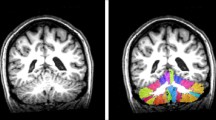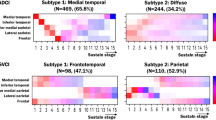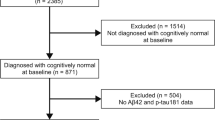Abstract
Alzheimer’s disease (AD) is a disease with dysfunctional brain network. Previous studies found the cerebellar volume changes over the course of AD disease progression; however, whether cerebellar volume change contributes to the cognitive decline in AD, or its earlier disease stage (i.e., mild cognitive impairment [MCI]) remains unclear. In ADNI, cognitive function was assessed using Alzheimer’s Disease Assessment Scale-Cognitive Behavior section (ADAS-Cog). We used linear regression and linear mixed effects models to examine whether cerebellar volume is associated with either baseline cognition or with cognitive changes over time in MCI or in AD. We used logistic regression to assess the relationship between cerebellar volume and disease progression to MCI and AD. We found that cerebellar volume is associated with cognition in patients with MCI, after adjusting for age, gender, education, hippocampal volume, and APOE4 status. Consistently, cerebellar volume is associated with increased odds of the disease stages of MCI and AD when compared to controls. However, cerebellar volume is not associated with cognitive changes over time in either MCI or AD. In summary, cerebellar volume may contribute to cognition level in MCI, but not in AD, indicating that the cerebellar network might modulate the cognitive function in the early stage of the disease. The cerebellum may be a potential target for neuromodulation in treating MCI.
Similar content being viewed by others
References
Drzezga A. The network degeneration hypothesis: spread of neurodegenerative patterns along neuronal brain networks. J Nucl Med. 2018;59:1645–8.
Hoenig MC, Bischof GN, Seemiller J, Hammes J, Kukolja J, Onur ÖA, et al. Networks of tau distribution in Alzheimer's disease. Brain. 2018;141:568–81.
Gould RL, Arroyo B, Brown RG, Owen AM, Bullmore ET, Howard RJ. Brain mechanisms of successful compensation during learning in Alzheimer disease. Neurology. 2006;67:1011–7.
Thomann PA, Schlafer C, Seidl U, Santos VD, Essig M, Schroder J. The cerebellum in mild cognitive impairment and Alzheimer's disease - a structural MRI study. J Psychiatr Res. 2008;42:1198–202.
Braak H, Braak E, Bohl J, Lang W. Alzheimer's disease: amyloid plaques in the cerebellum. J Neurol Sci. 1989;93:277–87.
Li YT, Woodruff-Pak DS, Trojanowski JQ. Amyloid plaques in cerebellar cortex and the integrity of Purkinje cell dendrites. Neurobiol Aging. 1994;15:1–9.
Wang HY, D'Andrea MR, Nagele RG. Cerebellar diffuse amyloid plaques are derived from dendritic Abeta42 accumulations in Purkinje cells. Neurobiol Aging. 2002;23:213–23.
Fukutani Y, Cairns NJ, Rossor MN, Lantos PL. Purkinje cell loss and astrocytosis in the cerebellum in familial and sporadic Alzheimer's disease. Neurosci Lett. 1996;214:33–6.
Sjobeck M, Englund E. Alzheimer's disease and the cerebellum: a morphologic study on neuronal and glial changes. Dement Geriatr Cogn Disord. 2001;12:211–8.
Wegiel J, Wisniewski HM, Dziewiatkowski J, Badmajew E, Tarnawski M, Reisberg B, et al. Cerebellar atrophy in Alzheimer's disease-clinicopathological correlations. Brain Res. 1999;818:41–50.
Baloyannis SJ, Manolidis SL, Manolidis LS. Synaptic alterations in the vestibulocerebellar system in Alzheimer's disease--a Golgi and electron microscope study. Acta Otolaryngol. 2000;120:247–50.
Mavroudis I. Cerebellar pathology in Alzheimer's disease. Hell J Nucl Med. 2019;22(Suppl):174–9.
Guo CC, Tan R, Hodges JR, Hu X, Sami S, Hornberger M. Network-selective vulnerability of the human cerebellum to Alzheimer's disease and frontotemporal dementia. Brain. 2016;139:1527–38.
Schmahmann JD. Cerebellum in Alzheimer's disease and frontotemporal dementia: not a silent bystander. Brain. 2016;139:1314–8.
KH E, Chen SH, Ho MH, Desmond JE. A meta-analysis of cerebellar contributions to higher cognition from PET and fMRI studies. Hum Brain Mapp. 2014;35:593–615.
Stoodley CJ, D'Mello AM, Ellegood J, Jakkamsetti V, Liu P, Nebel MB, et al. Altered cerebellar connectivity in autism and cerebellar-mediated rescue of autism-related behaviors in mice. Nat Neurosci. 2017;20:1744–51.
Schmahmann JD, Sherman JC. The cerebellar cognitive affective syndrome. Brain. 1998;121(Pt 4):561–79.
Schmahmann JD. Disorders of the cerebellum: ataxia, dysmetria of thought, and the cerebellar cognitive affective syndrome. J Neuropsychiatry Clin Neurosci. 2004;16:367–78.
Schmahmann JD, Weilburg JB, Sherman JC. The neuropsychiatry of the cerebellum - insights from the clinic. Cerebellum. 2007;6:254–67.
Stoodley CJ, Schmahmann JD. Functional topography in the human cerebellum: a meta-analysis of neuroimaging studies. Neuroimage. 2009;44:489–501.
Schmahmann JD. The role of the cerebellum in cognition and emotion: personal reflections since 1982 on the dysmetria of thought hypothesis, and its historical evolution from theory to therapy. Neuropsychol Rev. 2010;20:236–60.
Hickey CL, Sherman JC, Goldenberg P, Kritzer A, Caruso P, Schmahmann JD, et al. Cerebellar cognitive affective syndrome: insights from Joubert syndrome. Cerebellum Ataxias. 2018;5:5.
Hoche F, Guell X, Vangel MG, Sherman JC, Schmahmann JD. The cerebellar cognitive affective/Schmahmann syndrome scale. Brain. 2018;141:248–70.
Schmahmann JD. The cerebellum and cognition. Neurosci Lett. 2019;688:62–75.
Schmahmann JD, Guell X, Stoodley CJ, Halko MA. The theory and neuroscience of cerebellar cognition. Annu Rev Neurosci. 2019;42:337–64.
Tabatabaei-Jafari H, Walsh E, Shaw ME, Cherbuin N. Alzheimer's disease neuroimaging I. the cerebellum shrinks faster than normal ageing in Alzheimer's disease but not in mild cognitive impairment. Hum Brain Mapp. 2017;38:3141–50.
Jack CR Jr, Bernstein MA, Fox NC, Thompson P, Alexander G, Harvey D, et al. The Alzheimer's disease neuroimaging initiative (ADNI): MRI methods. J Magn Reson Imaging. 2008;27:685–91.
O'Brien LM, Ziegler DA, Deutsch CK, Kennedy DN, Goldstein JM, Seidman LJ, et al. Adjustment for whole brain and cranial size in volumetric brain studies: a review of common adjustment factors and statistical methods. Harv Rev Psychiatry. 2006;14:141–51.
Voevodskaya O, Simmons A, Nordenskjöld R, Kullberg J, Ahlström H, Lind L, et al. The effects of intracranial volume adjustment approaches on multiple regional MRI volumes in healthy aging and Alzheimer's disease. Front Aging Neurosci. 2014;6:264.
Vellas B, Andrieu S, Sampaio C, Wilcock G, European Task Force g. Disease-modifying trials in Alzheimer's disease: a European task force consensus. Lancet Neurol 2007;6:56–62.
Rosen WG, Mohs RC, Davis KL. A new rating scale for Alzheimer's disease. Am J Psychiatry. 1984;141:1356–64.
Mohs RC, Knopman D, Petersen RC, Ferris SH, Ernesto C, Grundman M, et al. Development of cognitive instruments for use in clinical trials of antidementia drugs: additions to the Alzheimer's Disease Assessment Scale that broaden its scope. The Alzheimer's Disease Cooperative Study. Alzheimer Dis Assoc Disord. 1997;11(Suppl 2):S13–21.
Battista P, Salvatore C, Castiglioni I. Optimizing neuropsychological assessments for cognitive, behavioral, and functional impairment classification: a machine learning study. Behav Neurol. 2017;2017:1850909.
Podhorna J, Krahnke T, Shear M, Harrison JE. Alzheimer's disease neuroimaging I. Alzheimer's Disease Assessment Scale-Cognitive subscale variants in mild cognitive impairment and mild Alzheimer's disease: change over time and the effect of enrichment strategies. Alzheimers Res Ther. 2016;8:8.
Hashimoto R, Meguro K, Lee E, Kasai M, Ishii H, Yamaguchi S. Effect of age and education on the trail making test and determination of normative data for Japanese elderly people: the Tajiri project. Psychiatry Clin Neurosci. 2006;60:422–8.
Romer AL, Knodt AR, Houts R, Brigidi BD, Moffitt TE, Caspi A, et al. Structural alterations within cerebellar circuitry are associated with general liability for common mental disorders. Mol Psychiatry. 2018;23:1084–90.
Cummings JL, Mega M, Gray K, Rosenberg-Thompson S, Carusi DA, Gornbein J. The neuropsychiatric inventory: comprehensive assessment of psychopathology in dementia. Neurology. 1994;44:2308–14.
Poulin SP, Bergeron D, Dickerson BC. Alzheimer's disease neuroimaging I. risk factors, neuroanatomical correlates, and outcome of neuropsychiatric symptoms in Alzheimer's disease. J Alzheimers Dis. 2017;60:483–93.
Strittmatter WJ, Saunders AM, Schmechel D, Pericak-Vance M, Enghild J, Salvesen GS, et al. Apolipoprotein E: high-avidity binding to beta-amyloid and increased frequency of type 4 allele in late-onset familial Alzheimer disease. Proc Natl Acad Sci U S A. 1993;90:1977–81.
Jack CR Jr, Petersen RC, Xu Y, O'Brien PC, Smith GE, Ivnik RJ, et al. Rates of hippocampal atrophy correlate with change in clinical status in aging and AD. Neurology. 2000;55:484–9.
Carmichael O, Schwarz C, Drucker D, Fletcher E, Harvey D, Beckett L, et al. Longitudinal changes in white matter disease and cognition in the first year of the Alzheimer disease neuroimaging initiative. Arch Neurol. 2010;67:1370–8.
Steuber V, Mittmann W, Hoebeek FE, Silver RA, De Zeeuw CI, Häusser M, et al. Cerebellar LTD and pattern recognition by Purkinje cells. Neuron. 2007;54:121–36.
Shim HG, Jang DC, Lee J, Chung G, Lee S, Kim YG, et al. Long-term depression of intrinsic excitability accompanied by synaptic depression in cerebellar Purkinje cells. J Neurosci. 2017;37:5659–69.
Kuo SH, Lin CY, Wang J, Sims PA, Pan MK, Liou JY, et al. Climbing fiber-Purkinje cell synaptic pathology in tremor and cerebellar degenerative diseases. Acta Neuropathol. 2017;133:121–38.
Wolff JR, Missler M. Synaptic reorganization in developing and adult nervous systems. Ann Anat. 1992;174:393–403.
Morara S, Colangelo AM, Provini L. Microglia-induced maladaptive plasticity can be modulated by neuropeptides in vivo. Neural Plast. 2015;2015:135342.
Jones TA. Motor compensation and its effects on neural reorganization after stroke. Nat Rev Neurosci. 2017;18:267–80.
Mohan A, Vanneste S. Adaptive and maladaptive neural compensatory consequences of sensory deprivation-from a phantom percept perspective. Prog Neurobiol. 2017;153:1–17.
Kim R, Healey KL, Sepulveda-Orengo MT, Reissner KJ. Astroglial correlates of neuropsychiatric disease: from astrocytopathy to astrogliosis. Prog Neuro-Psychopharmacol Biol Psychiatry. 2018;87:126–46.
Dayan E, Cohen LG. Neuroplasticity subserving motor skill learning. Neuron. 2011;72:443–54.
Bauer PM, Hanson JL, Pierson RK, Davidson RJ, Pollak SD. Cerebellar volume and cognitive functioning in children who experienced early deprivation. Biol Psychiatry. 2009;66:1100–6.
Buckner RL. The cerebellum and cognitive function: 25 years of insight from anatomy and neuroimaging. Neuron. 2013;80:807–15.
Colloby SJ, O'Brien JT, Taylor JP. Patterns of cerebellar volume loss in dementia with Lewy bodies and Alzheimers disease: a VBM-DARTEL study. Psychiatry Res. 2014;223:187–91.
Toniolo S, Serra L, Olivito G, Marra C, Bozzali M, Cercignani M. Patterns of cerebellar Gray matter atrophy across Alzheimer's disease progression. Front Cell Neurosci. 2018;12:430.
Zheng W, Liu X, Song H, Li K, Wang Z. Altered functional connectivity of cognitive-related cerebellar subregions in Alzheimer's disease. Front Aging Neurosci. 2017;9:143.
Budson AE, Solomon PR. New criteria for Alzheimer disease and mild cognitive impairment: implications for the practicing clinician. Neurologist. 2012;18:356–63.
Ferrucci R, Mameli F, Guidi I, Mrakic-Sposta S, Vergari M, Marceglia S, et al. Transcranial direct current stimulation improves recognition memory in Alzheimer disease. Neurology. 2008;71:493–8.
Cotelli M, Calabria M, Manenti R, Rosini S, Zanetti O, Cappa SF, et al. Improved language performance in Alzheimer disease following brain stimulation. J Neurol Neurosurg Psychiatry. 2011;82:794–7.
Turriziani P, Smirni D, Zappala G, Mangano GR, Oliveri M, Cipolotti L. Enhancing memory performance with rTMS in healthy subjects and individuals with mild cognitive impairment: the role of the right dorsolateral prefrontal cortex. Front Hum Neurosci. 2012;6:62.
Elder GJ, Taylor JP. Transcranial magnetic stimulation and transcranial direct current stimulation: treatments for cognitive and neuropsychiatric symptoms in the neurodegenerative dementias? Alzheimers Res Ther. 2014;6:74.
Funding
Dr. Chen has received funding from the National Institute of Health: NINDS #R01 MH118281 (principal investigator), NINDS #R01 MH100351 (principal investigator), and NINDS #R56 AG061163 (principal investigator). Dr. Tom has received funding from the National Institutes on Aging: NINDS #K01 AG050723. Dr. Kuo has received funding from the National Institutes of Health: NINDS #R01 NS104423 (principal investigator), NINDS #K08 NS083738 (principal investigator), and the Louis V. Gerstner Jr. Scholar Award, Parkinson’s Foundation, and International Essential Tremor Foundation.
Author information
Authors and Affiliations
Consortia
Contributions
Chi-Ying Lin: study concept, data analysis and interpretation, manuscript draft and revision; Chi-Hua Chen: study concept, data acquisition, analysis and interpretation, and critical revision of the manuscript for important intellectual content; Sarah E. Tom: data analysis and interpretation, critical revision of the manuscript of important intellectual content; Sheng-Han Kuo: study concept, data acquisition, analysis and interpretation, critical revision of the manuscript for important intellectual content, and study supervision.
Corresponding author
Ethics declarations
Conflict of Interest
The authors declare that they have no conflict of interest.
Additional information
Publisher’s Note
Springer Nature remains neutral with regard to jurisdictional claims in published maps and institutional affiliations.
Electronic supplementary material
ESM 1
(DOCX 28 kb)
Rights and permissions
About this article
Cite this article
Lin, CY., Chen, CH., Tom, S.E. et al. Cerebellar Volume Is Associated with Cognitive Decline in Mild Cognitive Impairment: Results from ADNI. Cerebellum 19, 217–225 (2020). https://doi.org/10.1007/s12311-019-01099-1
Published:
Issue Date:
DOI: https://doi.org/10.1007/s12311-019-01099-1




